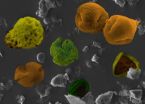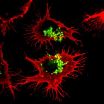(Press-News.org) PHILADELPHIA—An international team of scientists, including a leading evolutionary biologist from the Academy of Natural Sciences, have reset the agenda for future research in the highly diverse Amazon region by showing that the extraordinary diversity found there is much older than generally thought.
The findings from this study, which draws on research by the Academy's Dr. John Lundberg and other scientists, were published as a review article in this week's edition of Science. The study shows that Amazonian diversity has evolved as by-product of the Andean mountain uplift over millions of years, despite previous focus on the more recent history.
The vast Amazonian rainforest is arguably the most species-rich terrestrial ecosystem in the world, yet the timing of the original and evolutionary causes of this diversity are a matter of debate.
The authors compare modern diversity patterns with geological and molecular datasets and show that the highest species diversity in Amazonia today is found on a surface of Andean origin spanning more than a million square kilometers, which has been formed in the past 23 million years. This tight link between the geological history of the Andes and the development of the Amazon basin means that studies aiming to understand how the mega-diverse Amazonian forests have evolved need to look further back in time, to the past 20 million years.
Debate abounds on origin of Amazonian biodiversity
A wide range of scientific theories currently exist on the origin and complexity of the present day biodiversity in the Amazonian region. Though scientists have long suspected that the Andes influenced rainforest composition, the timing and causes have remained uncertain. In their review article, lead author Dr. Carina Hoorn of the University of Amsterdam, Lundberg, and their co-authors list the extraordinary flora and fauna that have evolved in the dynamic Amazonian landscape, which in turn has developed at a pace dictated by the reshuffling (Pacific) tectonic plates and subsequent uplift in the Andes. The paleogeographic evolution dictated by this geological reconfiguration included the formation of a vast wetland which, after the onset of the Amazon River around 10 million years ago, dried up and was open to colonization by plants and animals.
In this article, fittingly published in the International Year of Biodiversity, the authors encourage scientists to refocus when seeking explanations for the evolution of modern biodiversity. In the case of Amazonia, the pre-Quaternary flora and fauna already showed a very high level of species richness which was, in the case of reptiles and plants, even higher than found today.
"The Amazonian region, from its highest mountains to immense lowland rivers, supports a tremendous biological richness of species," said Lundberg, curator and Chaplin chair of ichthyology at the Academy of Natural Sciences in Philadelphia. "Many previously unseen species are discovered and documented every year."
INFORMATION:
About Dr. John Lundberg
Dr. John Lundberg has studied biological diversification in the Amazonian region for more than 30 years. His research focuses on fossils that document the ancient age of fishes—including species which still swim in South American rivers; on newly discovered living species of fish that were previously unknown; and on the evolution of South American landscapes including the changing courses of huge rivers. He has discovered and named more than 37 species and 12 genera of living and fossil fishes and is considered a world expert on catfish. Earlier this year he received the Robert H. Gibbs, Jr. Memorial Award from the American Society of Ichthyologists and Herpetologists for lifetime achievement in advancing fundamental knowledge of fish diversity.
The Academy of Natural Sciences, founded in 1812, is the oldest natural science research institution and museum in the Americas and a world leader in biodiversity and environmental research. The mission of the Academy is the encouragement and cultivation of the sciences.
Publication Details:
C. Hoorn, F.P. Wesselingh, H. ter Steege, M.A. Bermudez, A. Mora, J. Sevink, I. Sanmartín, A. Sanchez-Meseguer, C. L. Anderson, J.P. Figueiredo, C. Jaramillo, D. Riff, F.R. Negri, H. Hooghiemstra, J. Lundberg, T. Stadler, T. Sarkinen, A. Antonelli: 'Amazonia through time: Andean uplift, climate change, landscape evolution and biodiversity. Science (November 12, 2010).
Note to Press:
For more information you can contact: Dr. John Lundberg at lundberg@ansp.org. Starting Wednesday, Nov. 10, he also can be reached at 215-405-5069.
ACADEMY OF NATURAL SCIENCES ∙ 1900 BENJAMIN FRANKLIN PARKWAY ∙ PHILADELPHIA ∙ PA 19103
New explanation for the origin of high species diversity
Academy of Natural Sciences evolutionary biologist and colleagues pose evidence
2010-11-12
ELSE PRESS RELEASES FROM THIS DATE:
Tropical forest diversity increased during ancient global warming event
2010-11-12
The steamiest places on the planet are getting warmer. Conservative estimates suggest that tropical areas can expect temperature increases of 3 degrees Celsius by the end of this century. Does global warming spell doom for rainforests? Maybe not. Carlos Jaramillo, staff scientist at the Smithsonian Tropical Research Institute, and colleagues report in the journal Science that nearly 60 million years ago rainforests prospered at temperatures that were 3-5 degrees higher and at atmospheric carbon dioxide levels 2.5 times today's levels.
"We're going to have a novel climate ...
Study finds the mind is a frequent, but not happy, wanderer
2010-11-12
CAMBRIDGE, Mass. -- People spend 46.9 percent of their waking hours thinking about something other than what they're doing, and this mind-wandering typically makes them unhappy. So says a study that used an iPhone web app to gather 250,000 data points on subjects' thoughts, feelings, and actions as they went about their lives.
The research, by psychologists Matthew A. Killingsworth and Daniel T. Gilbert of Harvard University, is described this week in the journal Science.
"A human mind is a wandering mind, and a wandering mind is an unhappy mind," Killingsworth and ...
Voluntary cooperation and monitoring lead to success
2010-11-12
FRANKFURT. Many imminent problems facing the world today, such as deforestation, overfishing, or climate change, can be described as commons problems. The solution to these problems requires cooperation from hundreds and thousands of people. Such large scale cooperation, however, is plagued by the infamous cooperation dilemma. According to the standard prediction, in which each individual follows only his own interests, large-scale cooperation is impossible because free riders enjoy common benefits without bearing the cost of their provision. Yet, extensive field evidence ...
New vaccine hope in fight against pneumonia and meningitis
2010-11-12
A new breakthrough in the fight against pneumonia, meningitis and septicaemia has been announced today by scientists in Dublin and Leicester.
The discovery will lead to a dramatic shift in our understanding of how the body's immune system responds to infection caused by Streptococcus pneumoniae and pave the way for more effective vaccines.
The collaborative research, jointly led by Dr Ed Lavelle from Trinity College Dublin and Dr Aras Kadioglu from the University of Leicester, with Dr Edel McNeela of TCD as its lead author, has been published in the international peer-reviewed ...
Scientists demystify an enzyme responsible for drug and food metabolism
2010-11-12
For the first time, scientists have been able to "freeze in time" a mysterious process by which a critical enzyme metabolizes drugs and chemicals in food. By recreating this process in the lab, a team of researchers has solved a 40-year-old puzzle about changes in a family of enzymes produced by the liver that break down common drugs such as Tylenol, caffeine, and opiates, as well as nutrients in many foods. The breakthrough discovery may help future researchers develop a wide range of more efficient and less-expensive drugs, household products, and other chemicals. The ...
Gene discovery suggests way to engineer fast-growing plants
2010-11-12
DURHAM, N.C. – Tinkering with a single gene may give perennial grasses more robust roots and speed up the timeline for creating biofuels, according to researchers at the Duke Institute for Genome Sciences & Policy (IGSP).
Perennial grasses, including switchgrass and miscanthus, are important biofuels crops and can be harvested repeatedly, just like lawn grass, said Philip Benfey, director of the IGSP Center for Systems Biology. But before that can happen, the root system needs time to get established.
"These biofuel crops usually can't be harvested until the second ...
Stanford scientists identify key protein controlling blood vessel growth into brains of mice
2010-11-12
STANFORD, Calif. — One protein single-handedly controls the growth of blood vessels into the developing brains of mice embryos, according to researchers at the Stanford University School of Medicine. Understanding how the protein, a cellular receptor, functions could help clinicians battle brain tumors and stroke by choking off or supplementing vital blood-vessel development, and may enhance the delivery of drugs across the blood-brain barrier.
"The strength and specificity of this receptor's effects indicate that it could be a very important target," said Calvin Kuo, ...
Fortify HIT contracts with education and ethics to protect patient safety, say informatics experts
2010-11-12
Bethesda, MD—An original and progressive report on health information technology (HIT) vendors, their customers and patients, published online today, makes ground-breaking recommendations for new practices that target the reduction or elimination of tensions that currently mar relationships between many HIT vendors and their customers, specifically with regard to indemnity and error management of HIT systems. In light of the Obama Administration's $19 billion investment in HIT, paid out in ARRA stimulus funds, these recommendations are particularly significant in helping ...
Graphene's strength lies in its defects
2010-11-12
PROVIDENCE, R.I. [Brown University] — The website of the Nobel Prize shows a cat resting in a graphene hammock. Although fictitious, the image captures the excitement around graphene, which, at one atom thick, is the among the thinnest and strongest materials ever produced.
A significant obstacle to realizing graphene's potential lies in creating a surface large enough to support a theoretical sleeping cat. For now, material scientists stitch individual graphene sheets together to create sheets that are large enough to investigate possible applications. Just as sewing ...
New analysis explains formation of bulge on far side of moon
2010-11-12
SANTA CRUZ, CA--A bulge of elevated topography on the farside of the moon--known as the lunar farside highlands--has defied explanation for decades. But a new study led by researchers at the University of California, Santa Cruz, shows that the highlands may be the result of tidal forces acting early in the moon's history when its solid outer crust floated on an ocean of liquid rock.
Ian Garrick-Bethell, an assistant professor of Earth and planetary sciences at UC Santa Cruz, found that the shape of the moon's bulge can be described by a surprisingly simple mathematical ...
LAST 30 PRESS RELEASES:
Korea University Institute for Environmental Health completed an invited training to strengthen environmental health capacity for Karakalpakstan Medical Institute
Study offers evidence that racial bias is at play in overrepresentation of Black youth in Canadian child welfare systems
JMIR Publications’ JMIR Neurotechnology invites submissions on novel technological advances for neurological disorders
JACC issues inaugural report on state of US cardiovascular health
SwRI evaluates fire risks associated with solar panel installations
Discovery on how aggressive breast cancer controls protein production
A simple blood test can predict Crohn’s disease years before symptoms appear
FAU study reveals social, family and health factors behind teen bullying
New alliance trial seeks to reduce delays in gastrointestinal cancer treatment
Discovery of a new superfluid phase in non-Hermitian quantum systems
Codes in the cilia: New study maps how Cilk1 and Hedgehog levels sculpt tooth architecture
Chonnam National University researchers develop novel virtual sensor grid method for low-cost, yet robust, infrastructure monitoring
Expanded school-based program linked to lower youth tobacco use rates in California
TV depictions of Hands-Only CPR are often misleading
What TV gets wrong about CPR—and why it matters for saving lives
New study: How weight loss benefits the health of your fat tissue
Astronomers surprised by mysterious shock wave around dead star
‘Death by a thousand cuts’: Young galaxy ran out of fuel as black hole choked off supplies
Glow with the flow: Implanted 'living skin' lights up to signal health changes
Compressed data technique enables pangenomics at scale
How brain waves shape our sense of self
Whole-genome sequencing may optimize PARP inhibitor use
Like alcohol units, but for cannabis – experts define safer limits
DNA testing of colorectal polyps improves insight into hereditary risks
Researchers uncover axonal protein synthesis defect in ALS
Why are men more likely to develop multiple myeloma than women?
Smartphone-based interventions show promise for reducing alcohol and cannabis use: New research
How do health care professionals determine eligibility for MAiD?
Microplastics detected in rural woodland
JULAC and Taylor & Francis sign open access agreement to boost the impact of Hong Kong research
[Press-News.org] New explanation for the origin of high species diversityAcademy of Natural Sciences evolutionary biologist and colleagues pose evidence



